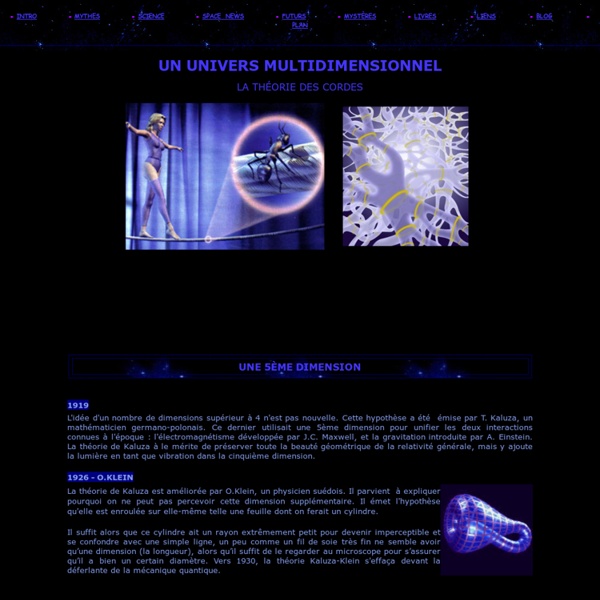



Space.com Buy This Infographic as a Full-Size Poster Astronomers have discovered more than 700 alien planets beyond the solar system, and the count is rising all the time. Some are large and hot, and others are smaller and cooler, but scientists are still on the lookout for an Earth twin. They just got closer, with the announcement Dec. 5 of a planet found by NASA's Kepler space telescope to lie in the habitable zone around its star where liquid water, and perhaps life, could exist. You can purchase a 20"x60" poster of this SPACE.com infographic on high-quality 14G Photo Paper from the SPACE.com store here: Buy Poster Embed: Paste the code below into your site. <a href=" alt="Astronomers searching for another Earth are getting closer, thanks to recent discoveries by the Kepler space telescope. " src="
ANATOMISK Grégomayannaise - angle de vision 360° - Intention du sujet que nous sommes en train de lire : Du pourquoi Anatomisk utilise un mélange de calendrier grégorien & Maya pour illustrer ses observation intégrale de l'évolution en cours. Sources : CJ Calleman : le calendrier Maya G Colombat : Bible et nombres Pascal Didier : la lettre chrétienne C. Pour une meilleure compréhension, à mettre en relation avec : --> Grégoire XIII --> 13:20 vs 12:60 --> 25*9*20 Du temps de la révolution française fomentée par les Illuminatis en 1776 + 13 = 1789, un nouveau calendrier avait été mis en place. A noter : - calendrier solaire (contemporain) 1 an = 365 1/4 jours - calendrier lunaire (musulman) 1 an = 354 1/3 jours - calendrier soli-lunaire (biblique) 1 an = 360 jours Néanmoins, 1583 devient la première date officielle du calendrier grégorien. Le calendrier Maya offre une autre vision du comptage du temps et par là-même, de notre perception de la réalité. A chaque KIN est apposé un signe du jour.
Hubble's Panoramic View Several million stars are vying for attention in this NASA/ESA Hubble Space Telescope image of a raucous stellar breeding ground in 30 Doradus, located in the heart of the Tarantula nebula. 30 Doradus is the brightest star-forming region in our galactic neighbourhood and home to the most massive stars ever seen. The nebula resides 170 000 light-years away in the Large Magellanic Cloud, a small, satellite galaxy of our Milky Way. No known star-forming region in our galaxy is as large or as prolific as 30 Doradus. The image comprises one of the largest mosaics ever assembled from Hubble photos and consists of observations taken by Hubble’s Wide Field Camera 3 and Advanced Camera for Surveys, combined with observations from the European Southern Observatory’s MPG/ESO 2.2-metre telescope that trace the location of glowing hydrogen and oxygen. The image is being released to celebrate Hubble’s 22nd anniversary. The colours come from the glowing hot gas that dominates regions of the image. Notes
QUELLE SCIENCE POUR DEMAIN Léon Raoul : A partir de cette dualité, nous allons découvrir le principe qui crée l'atome. Pour cela, nous n'allons pas prendre un aimant, mais deux aimants. Deux aimants qui se trouvent maintenant à grande distance séparés par du vide. Comment est-ce possible que les particules soient séparées par du vide puisque tout est rempli de cette force ? Eh bien à force de vouloir intégrer l'extérieur, la conscience a l'impression de grossir, de grossir, et les centres de volonté se concentrent. la conscience est d'abord + 5 - 5, + 100 - 100, + 100 000 - 100 000, et à force d'intégrer l'énergie qu'elle croit extérieure, sous forme de " grains ", elle finit par se trouver éloignée d'un autre centre de conscience où la même concentration s'opère. Frank : Il faut évidemment, pour comprendre cela, comprendre que l'esprit unique se croit partout, que le centre de la conscience est partout. Dans ces conditions, les deux pôles ne se freinent pas magnétiquement : ils se libèrent, ils se dégravitent.
Your Sky by John Walker Welcome to Your Sky, the interactive planetarium of the Web. You can produce maps in the forms described below for any time and date, viewpoint, and observing location. If you enter the orbital elements of an asteroid or comet, Your Sky will compute its current position and plot it on the map. Each map is accompanied by an ephemeris for the Sun, Moon, planets, and any tracked asteroid or comet. A control panel permits customisation of which objects are plotted, limiting magnitudes, colour scheme, image size, and other parameters; each control is linked to its description in the help file. Your Sky provides three ways to view the sky with links, where appropriate, among the various presentations. Sky Map The sky map shows the entire sky as viewed from a given location at a specified time and date. Horizon Views Horizon Views, showing the stars above the horizon as seen from a specified observing site at a given date and time. The Virtual Telescope Your Sky help Related Software
What comes next after the Noosphere? If I'm supposed to be serious about this, I'd go with the "Emotisphere"... which is the kind of emotional subtext to our lives, and/or maybe the collective emotional zeitgeist of any particular population, and which has a profound impact on the functioning of the noosphere. Like, for example, after 9/11, the emotisphere was polluted by panic and paranoia; which in turn dictated the functioning of other spheres, like the noosphere (like the discourse of politicians and pundits), and the technosphere (like the development of full body scanners for use in airport security). Having said that, I also want to propose something called the Thanatosphere; which isn't a system per se, but more of a piece of space-borne military equipment which resembles, but is not, a moon. It's a completely original idea, and I'd better not catch any upstart Hollywood auteurs stealing the idea for their movies about interstellar conflict.
The Worlds of David Darling noosphere mycelium